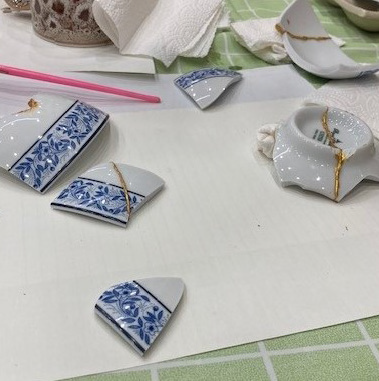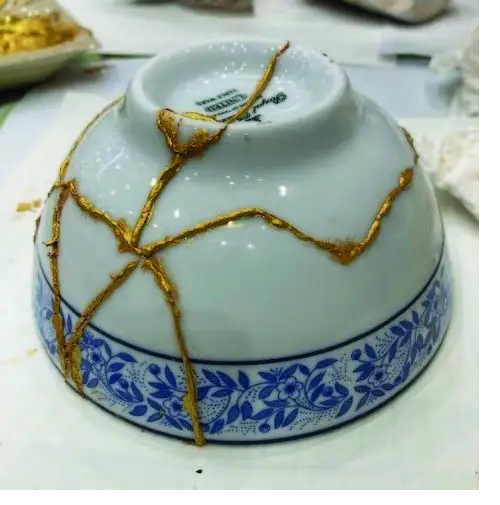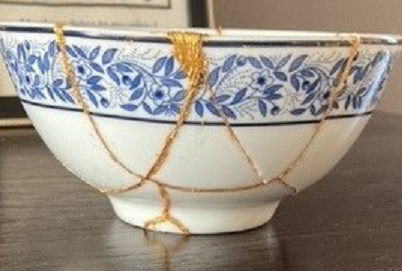
THE WOUNDS OF trauma are apparent in families, communities, and nations around the world. This includes trauma created by wars, conflict between people groups, civil disturbances, crimes, natural disasters, and epidemics.
SIM ‘s Trauma Healing Ministry is a church- and community-based outreach that equips believers with Bible-based and mental health principles to care for victims of trauma in their communities.
Our vision is to overcome gospel barriers created by trauma, through biblical, compassionate trauma care and to see every person experience healing in the Lord Jesus Christ.
Compelled by God’s great love and empowered by the Holy Spirit, we seek to equip the church to contend with brokenness and to proclaim the crucified and risen Christ.
Read this moving story by SIM’s Global Trauma Healing Coordinator Nancy Writebol, who discovered the ancient Japanese art of Kintsugi is a perfect metaphor for the healing power of the gospel…
When I chanced upon an art class while out with a friend in Thailand, I could never have imagined the impact it would have on both our lives. The class in the ancient Japanese art of Kintsugi was being offered as part of a cultural week put on in a shopping mall.
Kintsugi is the repairing of broken pottery with gold, understanding that the repaired object will be more beautiful than it was before it had been broken.
Kintsugi celebrates and finds beauty in imperfection and the value of a repaired piece is often far higher than the original, unbroken piece.
I’d been helping my friend through our trauma-healing courses and she had experienced deep, deep trauma. We took the class together and afterwards, shared what we had both experienced.
The class began with breaking a perfect bowl, smashing it with a hammer. It was like the impact of trauma, crushing your spirit; the impact of sin in the world, destroying what was once perfect.
When you’re broken, you wonder if you will ever heal.
Our broken dishes lay in so many pieces, reflecting the many pieces of our trauma – the memories of pain and sin; the emotions of rejection; of never feeling good enough, or smart enough; of fear and failure.
As we carefully wrapped the broken pieces in the towel, protecting ourselves from the sharp edges, we were reminded of how we had hidden our pain from those around us. We were surprised at how we carried the broken pieces with such care and gentleness – a reminder of how the Saviour carries us, of how the great shepherd cares for his sheep and promises to be near the broken-hearted.
The teacher told us how to lay the pieces out as if the bowl were not broken. She then mixed the gold pigment powder with the slow-drying glue.
Each piece was stuck together one at a time and held until the glue dried. Once the final pieces were stuck, we had to wait for them to dry before beginning the final polishing, smoothing off the rough edges.



…. and then lovingly smoothed to bring about a perfect and glittering restoration
As we waited, we became impatient, wanting things to move more quickly. But, as we should have known, healing takes time; grief and lament take time and cannot be rushed. So much time is spent on one bowl, but the golden repairs become a unique piece of the object’s history. That uniqueness only adds to its beauty.
Every one of us has some brokenness in our past. Perhaps we have grieved from a broken heart, complicated situations, loss of health, or relationships? Whether from choices we have made, or circumstances beyond our control, sometimes we find ourselves so profoundly broken that we don’t know how things could ever be restored.
But God changes everything. He gives us hope! He lovingly scoops up the broken pieces of our lives and painstakingly puts us back together, broken piece by broken piece. He fills in the cracks with the gold of his love and life.

“The Lord is near to the broken-hearted and saves the crushed in spirit.” Psalm 34:7
Only God can restore us. We cannot repair ourselves, any more than a shattered bowl can repair itself. That’s why we need a Saviour. We need Jesus – he is the only one who has the power and knows how to fix what is broken.
Suffering is an opportunity to learn and trauma healing offers a participatory approach that allows for engaging the mind, emotions and body together.
At the heart of the trauma material are practical lessons that lead people on a journey of healing; lessons in identifying wounds of the heart with grieving and lamenting as part of the journey.
Trauma silences people’s voices because it seems too horrific to put into words and at times like this, we often look to the Psalms as we lament to give us voice.
But we not only need to learn to lament; we also need to learn from lament, because it allows us to hear the lessons God intends to teach us through pain. As C.S. Lewis famously said, ‘God whispers to us in our pleasure, speaks in our conscience, but shouts in our pains: It is his megaphone to rouse a deaf world.’
Pray
- For those going through trauma healing to be healed and restored as they trust in Jesus.
- For God to raise up more workers to bring healing to traumatised communities and to continually point to Jesus as they help those in their care.
- For those trying to deal with trauma on their own, that God would open up ways for them to connect with those who can help.
